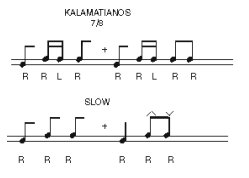
[Editor's note: I made some minor edits, inserted a couple of clarifications and fixed some hard-to-read sentences. Some of his comments refer to a previous version of my page. -Jas]
Dear Mr Senn
I am writing to you to express my satisfaction, that I finally found some interesting web pages on the net, which concern rhythms and training on the doumbec and which I think concern all those -advanced and beginners- who are interested in learning the rhythms and the "philosophy" of this percussion instrument.
Please, let me place some notes of mine, you will probably find interesting and useful and since you claim you are open to observations, I think they will be welcome, as well. These notes are about Greek traditional rhythms, including those you have already registered on your web pages.
Firstly, the doumbec in Greece is called toumberleki or toumbeleki and less often darambouka. It is widely used in the traditional music of my country, since each geographical region has its own musical tradition and sound style as well. Other percussion instruments I can refer to are: the daouli, the dephi (deff), the dayres (a larger bendir), the zilia (zills), the tambouro, the komboloy, the nakares, the woodspoons, the kambanes (little bells), some sticks of different types and finally the masha (the iron poker we move the wood with in the fireplace) with zilia adapted to the edges of its opening.
About the rhythms now: the kalamatiano, as you mention, is played at music nightclubs and it is used to colour particular points, but one cannot dancing like this [sic], because each rhythm is written for the dancer's step especially in row dances. [Jas: here I think Manthos means that, although this rhythm is written in 7 beats, it is played with wide variation of timing to "fit" the dance or melodic piece that is being performed.] The traditional execution is this one:

As for the tsamiko now, I have heard the rhythm you mention, but only in Arabian songs. The tsamiko, which is the rhythm of the Greek national hymn goes this way (like Quddaam):
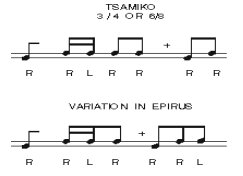
Moreover, the description you give of the Zeymbekiko is rather "touristic" and it reminds us of the Zorba the Greek [Jas- It wasn't my description - but point taken]. The Zeymbekiko existed before the period between the wars and the rembetika songs. It is a traditional male dance performed since the 17th century on the east islands of the Aegean Sea (Samos, Chios, Mytilini etc) and on the coasts of Minor Asia. The rhythm and especially the variation you mention, is played somehow slowly and "widely" (9/4). There is a great difference in the style, which is not the same with the maqsum. In rembetika songs it is played faster. I remind you that, since the Zeymbekiko is strictly a male dance, its execution must be as plain as possible, although nowdays it is danced by little girls, too.
Another variation of the Zeymbekiko is the "Camilieriko" (it means the characteristic way of camel's stepping or the camel's guide rhythm) and it goes:

A third version is the "Aptaliko" (coming from Attalia, Minor Asia) and its rhythm is
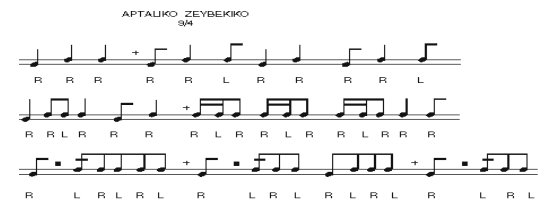
That is, we first play the 3/8 of the version you mention and then the rest 6/8. In the Aptaliko we can use many more strokes and alternative forms and the velocity is faster.
But the most interesting version of all, in my opinion, is the "Antikrysto Zeymbekiko of Smyrni" [a dance for couples in which the man used to dance opposite (Greek word=antikry, turkish word=karsh, like karshlama)]. The city of Smyrni on the coasts of Minor Asia (today's Turkish name is Ismir) and many other towns and villages in that area were residential parts mostly of Greeks till 1922, who were persecuted or slaughtered by the Turkish army, that finally ruined the area putting fires on. The songs and the rhythms the refugees brought with became the basis for the Rembetika songs and also for the latest Greek popular music, while they are being sung nowdays and the most possible is to be sung for long. The well-known song "Misserlu" is of Minor Asia origin of the 19th century (at least people says so here) and it has been recorded in a lot of versions by Greek musicians. A typical band in Smyrni, except for the doumbec, had also the violin, santouri, outi (oud), canonaki (canoon) or mandolin. The rhythm Antikrysto Zeymbekiko of Smyrni goes like this (where 3f mean a quick successive stroke of the ring finger, middle finger and index finger of the left hand on the membrane):
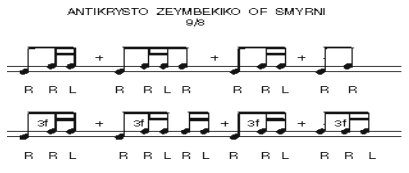
A further observation has to do with the Syrtos (in Smyrni it was also called ballos). It is 2/4 and it goes like this:
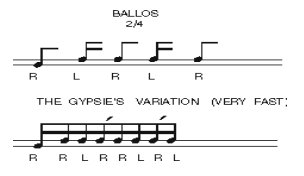
The rhythm of the Syrtos or Ballos is used in nearly a quarter of the Greek songs today. The 2nd variation is usually played by gypsies and it is Goran Bregovich's basic rhythm in Emir Custuritsa's films (the director of "Arizona dream") in witch the highlights fall on gypsies and their way of living (e.g. "le temps des gitanes"). Gypsies in Greece and generally in the Balkans plays interesting music and they are very dexterous, but their rhythms are poor (all 2/4 and 4/4), so they enrich them with different variations.
The "Sousta" is another basic rhythm of the Greek traditional music. It is a line dance found on the islands of the Aegean Sea and on Crete (if you play 3 meters of the Syrtos and 1meter of Sousta or vice-versa you can have a very good version). The Sousta is performed this way:
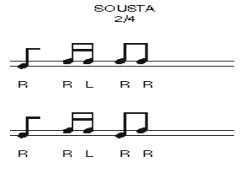
The second version I can also mention is about another row dance called Chassaposserviko or Politiko Chassapiko (it's a rhythm of Constantinoupolis, today's Turkish name Istanbul). The musics of Constantinoupolis and of Smyrni are the most "eastern" Greek traditional music. The music of southern Crete has also a similarity to the Arabian music (but a different orchestration) and one of its basic rhythms is the Maqsum but in a slower playing. The rhythm of the Maqsum is called Tsifteteli in Greece (it's an ancient Greek dance called Cordax). The rhythm you call Tsifteteli I think is a Turkish version but is very popular in Greece too, after all these structures are almost alike. The most widely spread version of the Tsifteteli in Greece comes from Smyrni again and goes like this:
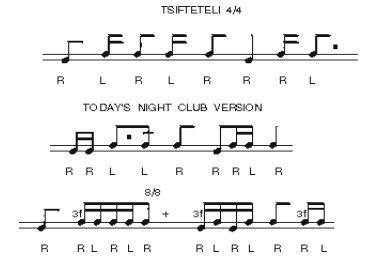
It is of a great interest to observe the geography of music in the Mediterranean countries. In Thrace, in the South coasts of the Black Sea and in the area of Trapezounta (today's Turkish name Trabzon) where a lot of Greek people used to live until 1922, there's a rhythm of 7/8 or 7/16 that is called Mantilatos. (Mandilia=handcerchiefs). The dancers in order to perform it waved handkerchiefs in the air. It goes like this:
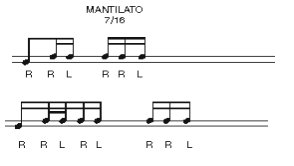
This rhythm is a very fast one. The Kalamatianos (coming from Kalamata, a port in South Greece) is also 7/8 and it is played at the half the velocity of Mantilatos. If one moves down South to the Arabian coasts or East to the islands of the Aegean Sea, he can meet the slow and long flowing 7/8 (or it is 7/4?) Dawr Hindi and Devra Hindi (in Greece we call them simply slow Kalamtianos and dance them the man opposite the woman). You realize that the rhythms in the East Mediterranean countries are somehow alike and that the differences in their style are not big. I think that they are the only countries where you can find rhythms in which the numerator in the rhythm fraction is an odd number. That happens in Greece, because we are the musical heirs of ancient Greece through Byzantium (at least we think so). This explanation probably partially applies to the Arabian rhythms, as it is known that Arabs appeared later in the Mediterranean Sea and their culture (music, religion etc) was probably influenced by the pre-existed cultures of the area.
The Byzantine musical notation had no numbers. It consisted of a completely different system. The melody groups were called "dromi" (ways) -the well known taqsim- the rhythms called "echi" and "plagei echi" (echi=sounds, see echo). The notes were PA, VU, GA etc, it was mainly ritual music, something like gospels, but only those who study Byzantine music are aware of further details. But all the above mentioned rhythms were found on the coastal areas of Greece. There are, also, some other areas in Greece with a remarkable musical tradition such as Epirus (Northwest Greece) that has a musical tradition which can be described as "Greek jazz" by some intellectuals. As an example I mention a rhythm 15/8 or 15/16 (10+5) that is performed in Greek Macedonia, Serbia and FYROM. It's called "Pousnitsa" (Serbian word):
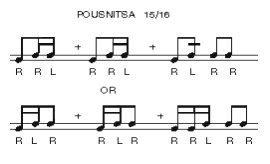
I hope I haven't tiresome to you. I would be glad to have a response from you and I will be at your disposal any time (send-ing you more informations and rhythms if needed). I feel sorry for not having the appropriate hardware and software to provide you with WAV files (MIDI files are a solution but they don't reflect the mood and the sound palette). I think that you can find this kind of music in the U.S. music market, that I strongly recommend and it's my belief that these melodies, as purely Mediter-ranean will thrill you.
Manthos Garlofis
Larissa, Greece, office employee and student of the laographical center at percussions